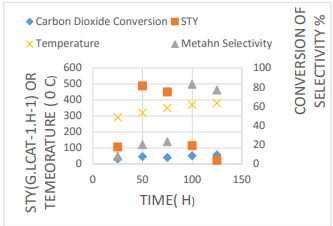Composite Catalytic System for the Conversion of Carbon Dioxide to Useful Compound
Keywords:
CO2 utilization, syngas, higher alcohols, Fischer-TropschAbstract
This experimental work done on the production of valuable product from Carbon dioxide by composite catalytic conversion system of carbon dioxide to Alcoholic and acidic compounds. Different mixtures of catalysts utilized to check and enhanced the reactivity of the system as well as increased the production of Valuable product from Carbon dioxide: Fischer-Tropsch synthesis, hydrogenation, water-gas-shift and methanol synthesis. These results showed that composite catalytic system played important role for the syntheses of valuable products from Carbon Dioxide. We have concluded that if methanol synthesis sites were present adjacent to the carbon –carbon chain growth sites, the formation rate of C2 oxygenates would be increases. Production of methanol increased by increasing temperature and using of catalyst PdZnAl in composite catalytic system. Composite catalyst (PdZnAl ) was stable at high temperature 390 ◦C. It was showed that conversion efficiency was high at high temperature. The results showed that the process can be emphasize by operating at high temperature using Pd-based methanol synthesis catalyst. Organic Byproduct of the steam reforming was demonstrated that a means to facilitate additional hydrogen. Primary process design for the Composite Catalytic System for The Conversion of Carbon Dioxide to Valuable Compound, simulation, and economic analysis of the proposed were carried out. It is observed from analyses data Cost of the Carbon dioxide and hydrogen increase the production cost of the Methanol
References
Erdogan,alper, oze yuksel, orhan, amanuscript accepted, co2 utilization: development in conversation process, 2016.
cooper h w. chem eng prog, 2010, 106(2): 24
centi g, cum g, fierro j l g, lopez nieto j m. direct con-version of methane, ethane and carbon dioxide to fuels and chemicals, 2008, cap report, the catalyst group resources
Ritter S K. Chem Eng News, 2007, 85(18): 11
Graham-Rowe D. New Sci, 2008, 197(2645): 32
Inui T, Yamamoto T, Inoue M, Hara H, Takeguchi T, Kim J B. Appl Catal A, 1999, 186(1-2): 395
Lebarbier V M, Dagle R A, Kovarik L, Lizarazo-Adarme J A,
Centi G, Perathoner S. Catal Today, 2009, 148(3-4): 191
Inui T, Hara H, Takeguchi T, Kim J B. Catal Today, 1997, 36(1): 25
Inui T, Yamamoto T. Catal Today, 1998, 45(1-4): 209
Subramanian N D, Gao J, Mo X H, Goodwin J G, Torres W, Spivery J J. J Catal, 2010, 272(2): 204
Gerber M A, White J F, Gray M J, Thompson B L, Stevens D J. Optimization of Rhodium-Based Catalysts for Mixed Alcohol Synthesis-2009 Progress Report, December 2010, PNNL-DOE Formal Report
Christensen J M, Mortensen P M, Trane R, Jensen P A, Jensen A D. Appl Catal A, 2009, 366(1): 29
King D L, Palo D R. Catal Sci Technol, 2012, 2(10): 2116.
Xia G, Holladay J D, Dagle R A, Jones E O, Wang Y. Chem Eng Technol, 2005, 28(4): 515
Twigg M V ed. Catalyst Handbook, 2nd ed. London: Wolfe Publishing Ltd., 1989
Hu J L, Dagle R A, Holladay J D, Cao C S, Wang Y, White F, Elliott D C, Stevens D J. US Patent 7858667, 2007
Chin Y H, Dagle R, Hu J L, Dohnalkova A C, Wang Y. Catal Today, 2002, 77(1-2): 79
Hu J L, Wang Y, Cao C S, Elliott D C, Stevens D J, White J F. Catal Today, 2007, 120(1): 90
Soudabeh Rahmani,a Fereshteh Meshkani ,a,b and Mehran Rezaeia,b, Preparation of Ni-M (M: La, Co, Ce, and Fe) Catalysts Supported on Mesoporous Nano crystalline γ-Al2O3 for CO2 Methanation, published online 00 Month 2018 in Wiley Online Library (wileyonlinelibrary.com). DOI 10.1002/ep.13040.
Rashi Gusain, Pawan Kumar, Om P.Sharma, Suman L.Jain,OmP.Khatri,Reduced graphene oxide-CuO nano composites for photo catalytic conversion of CO2 into methanol under visible light irradiation, Applied Catalysis B, Environmental http://dx.doi.org/10.1016/j.apcatb.2015.08.012.

Downloads
Published
How to Cite
Issue
Section
License

This work is licensed under a Creative Commons Attribution 4.0 International License.
Authors contributing to this journal agree to publish their articles under the Creative Commons Attribution 4.0 International License, allowing third parties to share their work (copy, distribute, transmit) and to adapt it, under the condition that the authors are given credit and that in the event of reuse or distribution, the terms of this license are made clear.





